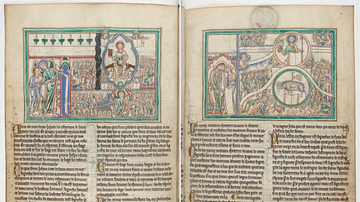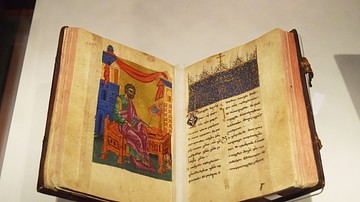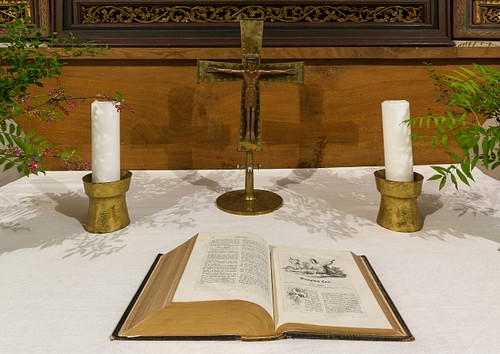
New Testament is the name for the second half of the Christian Bible, compiled from the 2nd century CE, after the separation of Christianity from Judaism. The Christian Bible retained books of the Jewish scriptures, the Old Testament, as "proof" to support the new system of belief formed around Jesus Christ. The New Testament consists of four gospels, the Acts of the Apostles, the letters of Paul the Apostle to the Gentiles, and the Book of Revelation.
Etymology
"Testament" became the English translation for a shared religious and cultural concept in the ancient world, that of "covenant." A covenant was a legal contract upheld and sworn to by oaths and rituals. We have examples between overlords and constituents.
All ancient religions had contracts between their gods and humans. The contract detailed the relationship between society and the divine. Covenants had two essential elements: 1) the god's promise to help the community to prosper in return for worship, which meant sacrifices, and 2) law codes that detailed behavior and gender roles. Law codes were manifest in forms of governing, originally through kings, and were validated by the fact that they were given by the gods. The Jewish scriptures have detailed covenants between God and his people.
The Hebrew for covenant (beriyth) meant a promise or a pledge. In the Greek translation of the Hebrew scriptures, beriyth became diatheke, a Greco-Roman concept of jurisprudence that described a last will and testament. The King James version used "testament" as a description of the eternal covenants of God.
The Emergence of Christianity
When the Christian movement emerged in the 1st century CE, Jewish believers who claimed that Jesus of Nazareth was the messiah promised by the prophets, turned to the Jewish scriptures to validate their claims. At the time, the common collection of the Jewish scriptures was the Septuagint Bible. The Ptolemaic Dynasty in Alexandria Egypt commissioned a translation of the Hebrew texts into Greek, as Greek was the lingua franca of the region. The Septuagint Bible had 51 books. This was the version used by Paul the Apostle and the gospel writers.
Canon was a Greek term for "measurement," later adopted to "measure" which books were deemed sacred and which were not. The writers of the gospels utilized the Scriptures as needed, but there was no accepted canon in early Christianity. Luke, the author of the third gospel and the Acts of the Apostles, utilized many of the other books of the Septuagint that ultimately did not make it into the official canon of either the Jewish scriptures or the New Testament.
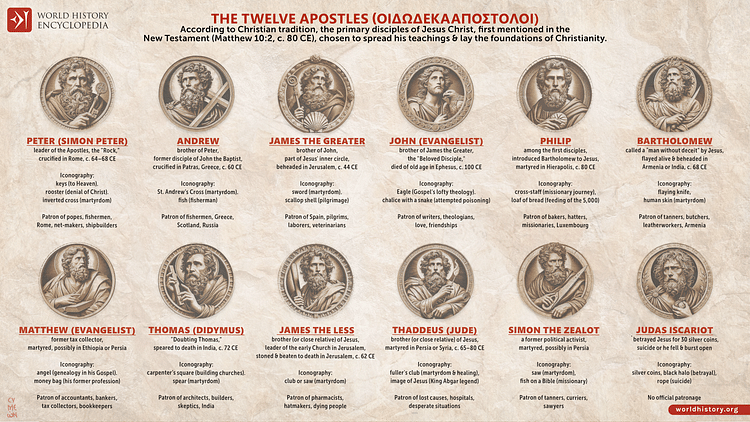
Roman Persecution of Christians
At the end of the 1st century CE, the Roman emperor Domitian (r. 83-94 CE) began persecuting Christians for the crime of atheism, disbelief, and non-participation in the state cults of Rome. There was no distinction between religious law codes and civil laws. It was dangerous to anger the gods; going against the dominant culture, atheism was the equivalent of treason, which carried the death penalty. The Jews were exempt from Roman cults by an act of Julius Caesar in 45 BCE, who had rewarded the service of Jewish mercenaries in the East by promising they could be free to practice their ancestral customs. There was a tacit agreement, however, that Jews were not to recruit or interfere with the dominant culture beyond the synagogues.
Jews were known for their unique identity markers, circumcision, and dietary laws. Christians upheld the same beliefs and precepts of Judaism, but the majority of Christians were ex-pagans, not ethnic Jews. The early Christian communities had decided that pagan converts were not required to undergo circumcision (Acts 15). Hence, Christians could not appeal to the same privilege of exemption. At the same time, Christians were, in fact, encouraging pagans to convert, to cease traditional idolatry.
The Church Fathers of the 2nd Century
Christian bishops in the 2nd century CE began writing treatises and arguments to Roman emperors and magistrates for why the persecution of Christians should cease. Retrospectively entitled "Church Fathers", they were honored as the originators of what became Christian dogma. There were dozens of treatises, but the dominant views were from Justin Martyr (100-165 CE), Irenaeus of Lyons (c. 130-202 CE), Clement of Alexandria (c. 150- 215 CE), and Tertullian (155-220 CE).

The Church Fathers were ex-pagans who had converted to Christianity, educated in Greek philosophy. They had no ethnic relationship to Judaism but were well-versed in the Jewish scriptures in their claim that Jesus was the messiah predicted by the prophets of Israel. They addressed multiple issues and utilized various literary devices in their arguments. Scholars have classified the literature into three areas:
- Apologies
Apologia, apology is not being sorry for something, but a style of writing that defines and explains a topic. Historically, the apologia were the first attempts to fully present Christianity as a complete system and way of life. The Roman Empire was averse to new religions, particularly those from the East which often included wonder-workers. Some Roman philosophers had criticized Christianity as a "false philosophy". The Fathers' response utilized Greek philosophy to argue that it was based upon the same concepts of the classical schools. They applied Plato's doctrine of the logos, the concept of rationality manifest in the material world. In Philippians 2, Paul introduced the concept of a pre-existent Christ, present at creation, who chose to be manifest in a physical body and then was exalted to heaven after his resurrection. The mistake of philosophers was not understanding that Plato's logos was actually Christ. - Adversos Literature
Adversos meant adversary. Adversos literature are the writings against Jews and Judaism, 'the adversaries' of Christians. Christians argued for an exemption from persecution on the basis that their beliefs were not new. Christians upheld the one God of Judaism which had a long history. Justin Martyr claimed that Christians were the true Jews of God's original covenants. These treatises against the Jews consistently charged Judaism with corruption, which is why God sent Christ into the world to preach against it. The proof was in the fact that God had permitted Rome to destroy the Temple in 70 CE during the Great Jewish Revolt of 66 CE. - Heresiologists.
A heresiologist is defined as an expert in the study of heresy but applied retrospectively to the Church Fathers. In the 2nd century, we have dozens of different "gospels," collectively described as Gnostic gospels. "Gnostic," from gnosis ("knowledge), described secret knowledge concerning both the nature of Jesus and his role in salvation. In response, The Church Fathers invented the concepts of orthodoxy and heresy. Orthodoxy meant correct belief. The word heresy was derived from the Greek term for a school of philosophy, haeresis. The Church Fathers declared that anyone who did not agree with their concepts and rituals was guilty of incorrect belief and actions and thus, heresy.
The longest treatise against the Jews is Justin Martyr's Dialogue with Trypho the Jew. It is an alleged conversation between Justin and Trypho, a Jewish refugee who came to Rome after the failure of a second Jewish uprising, the Bar-Kokhba Revolt (132-136 CE). Scholars debate the historicity of Trypho as well as the conversation; ancient writers often created a strawman to which they could assign points of view, setting up their subsequent refutation of each topic.
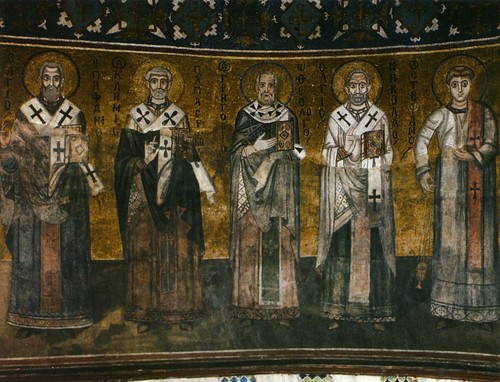
In his dialogue with Trypho, Justin Martyr used the recent rebellion as the starting point to demonstrate to Rome that Christians were peace-loving, and good, patriotic citizens of the Roman Empire. In contrast, one only needs to consult the Jewish Scriptures to see that the Jews, by their stubborn nature, had always been disobedient to authority, even to the commandments of God.
Allegory
Through the device of allegory, Justin made the most significant contribution to the formation of the Christian Bible. To demonstrate that Christianity was not new, he used the literary device of allegory for his proof of antiquity. Allegory contains symbolic reinterpretations of an event or story to elucidate a new meaning of a text. Surveying the Jewish scriptures, there were figures of types which pointed to Christ"
The mystery, then, of the lamb which God enjoined to be sacrificed as the Passover [Paul's paschal sacrifice in 1 Corinthians 5:7], was a type of Christ; with whose blood, in proportion to their faith in him, they anoint their houses . . . knowing that the days will come, after the suffering of Christ, when even the place in Jerusalem shall be given over to your enemies, and all the offerings, in short, shall cease; and that lamb which was commanded to be wholly roasted was a symbol of the suffering of the cross which Christ would undergo. For the lamb, which is roasted, and dressed up in the form of the cross [the spits of wood]. (Trypho, XL)
Justin claimed that the binding of Isaac pointed to the binding on the cross. Only this time, God accepted this pure sacrifice. When the Israelites battled various tribes in the wilderness on their way to Canaan, Moses stood with his arms raised up, and they would win. When he tired, and his arms fell, they would lose. This symbolized that salvation was granted by the raised arms of Christ on the cross.
Educated in Greek philosophy, Justin portrayed the God of Israel as the abstract, original highest god of philosophy, one unified power who created the universe. This philosophical monotheism maintained the worship of God, to the exclusion of all other gods.
God did not visit the earth and communicate with people. This Jewish belief was their mistaken interpretation of their own history. It was not God who conversed with Moses from a burning bush, but the pre-existent form of Christ as the logos. Everywhere in the Scriptures where one reads God, it was always Christ in his pre-earthly manifestation. Christ was present and involved in the creation of the universe. Through analogy, the Church Fathers claimed that all the prophets of Israel had predicted Jesus of Nazareth as the messiah.
Jeremiah was the prophet during the Babylonian conquest and destruction of Jerusalem and Solomon's Temple (587 BCE). There are 40 direct quotations from Jeremiah in the Christian New Testament. In Jeremiah 31:21-34:
"The days are coming," declares the Lord, "when I will make a new covenant with the people of Israel and with the people of Judah. It will not be like the covenant I made with their ancestors when I took them by the hand to lead them out of Egypt, because they broke my covenant, though I was a husband to them," declares the Lord. "This is the covenant I will make with the people of Israel after that time;" "I will put my law in their minds and write it on their hearts. I will be their God, and they will be my people. For I will forgive their wickedness and will remember their sins no more."
Hence, Christians should retain the "old testament" for Christian faith because it served as "proof from scripture," as a witness to the new system offered by Jesus. At the same time, "a covenant written on their hearts" was the justification for the acceptance of ex-pagans without the identity markers of ethnic Jews. No longer Jews, no longer pagans, Christianity became a new, separate religion in the Roman Empire.
Marcion of Sinope (85-160 CE)
Sinope was in the province of Pontus, on the southern shore of the Black Sea. Marcion was the son of the bishop of Sinope, who was a wealthy shipbuilder. Marcion's father allegedly excommunicated him for his teachings. His major work, Antithesis (in five books) is lost but was quoted extensively by the Church Fathers. He was nicknamed the "wolf of Pontus" in an entire treatise by Tertullian (Adversus Marcionem). He emigrated to Rome c. 140 CE with his followers who were all celibate Christians. He paid for their travel, room, and board. He also brought a donation to the church in Rome (140,000 sesterces), which the Church Fathers scorned and rejected. Excommunicated from Rome, he was declared a heretic.
Unlike other Gnostic groups, who only founded schools, Marcion founded his own church, with its own hierarchy of bishops, priests, and deacons. In this way, he gained more followers than other divergent teachers, so that ten years after his excommunication, Justin Martyr wrote that he caused many of every nation to speak blasphemies.
Marcion taught that Jesus's humanity and suffering were illusions. According to Marcion, Jesus was not born of the Virgin Mary; he was not born at all but simply appeared suddenly in the synagogue of Capernaum. Jesus was the manifestation of a higher god, a god of love. Jesus retained the appearance of humanity until his death on the cross, by which he redeemed souls from the dominion of the creator God of Judaism.
The God of Judaism was a god of justice. His sole function was to reward good and punish evil. The God of Israel is inconsistent, changing his mind (his regret at creating humans, the story of the flood) and punishing the innocent as well as the guilty with national disasters. He is quick to anger and jealous of any other powers (by his own admission). But Jesus taught forgiveness: "Love your enemies, do good to those who hate you, bless those who curse you, pray for those who abuse you" (Luke 6:27-28). The Jews' view of the messiah was solely as a kingly warrior, ultimately of benefit to the Jews. But Jesus offered salvation to all the nations. As such, the history of the Jews and their scriptures, the "old testament," was no longer valid.
Marcion proposed that Christians should have their own sacred scriptures. A great admirer of Paul, he claimed that Paul's description of an out-of-body journey to heaven in 2 Corinthians gave him insight into the true nature of God and Jesus. Marcion's Christian scriptures contained ten letters of Paul, and one gospel, that of Luke. He claimed that Luke was the only writer who understood Jesus' true nature.
However, he rallied against the fact that someone had added the many references to the prophets in Paul's letters (especially Isaiah), and Luke's references to the prophets and the history of Israel. He edited out those sections. It must have been an exceedingly small edition. Marcion was the first to use the term "new testament".
Formation of the New Testament Canon
The significance of Marcion's proposed scriptures is found in the reaction of the Church Fathers. Between 140 and 200 CE, the formation of what became the New Testament began to evolve in response to Gnosticism, but also in response to Marcion's proposed canon. Where Marcion had ten letters of Paul, the Church Fathers had 14. Instead of a single gospel, they had four. They selected the four with the argument that these four were not only the earliest, but they claimed that they were in the communities from the earliest days, in a concept known as the apostolic tradition. Jesus taught the disciples, who then appointed the first bishops, and so Christian views remained unchanged.
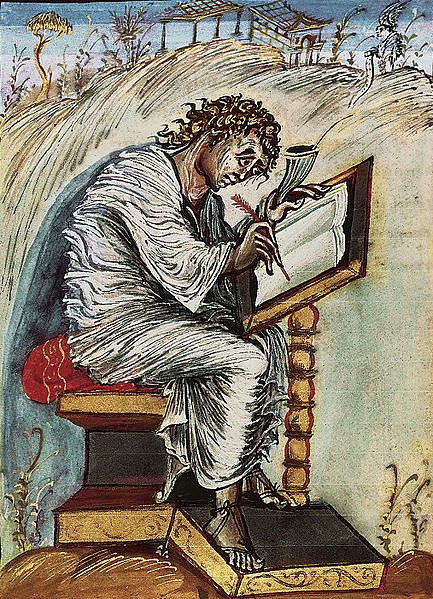
It was during this period that the four were assigned their names and they proposed background traditions of the writers. The rejection of any other gospels or points of view was justified by Irenaeus as God's intention, pointing to the number of cardinal points and seasons.
New Testament scholars agree that Paul wrote seven letters, and the others remain debatable as "Deutero-Paul", letters written by his disciples claiming to be Paul so that they would carry authority.
The Christianization of the Roman Empire
With Constantine’s conversion to Christianity, the Edict of Milan permitted Christians to legally assemble from 313 CE. Because of continuing debates over the relationship of Christ to God (the Aryan schism), he called for an empire-wide council at Nicaea in 325 CE. The First Council of Nicaea produced what became the Christian concept of the Trinity and established the Nicene Creed, what all Christians should believe. Anyone who disagreed with the now-Christian emperor was guilty of heresy, subject to the death penalty.
When Constantine the Great converted, he converted to the theology of the Church Fathers. According to Eusebius' Life of Constantine, he ordered 50 copies of the gospels to be issued throughout the Empire. We cannot verify which ones at the time, but ultimately these four became the "canonical" gospels that were universally accepted.
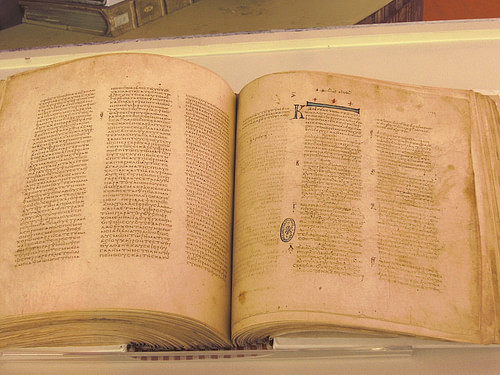
Our earliest list of the New Testament canon comes from what is known as the Muratorian Fragment, dated anywhere from 170-200 to the 4th century CE. A bishop of Alexandria, Athanasius (296-298 CE) produced a canon of 27 books. The modern New Testament lists 27 books: four gospels, the Acts of the Apostles, epistles (letters), and one apocalypse.
Over the centuries, debates continued on the inclusion of the books of Jewish Scriptures in the Catholic Church, the Eastern Orthodox Communities, and various denominations of the Protestant Reformation. Most of the differences concern the books in the Septuagint and apocryphal writings. The Catholic canon comprises 46 books, the Orthodox churches have 49 and Protestants have 39.



